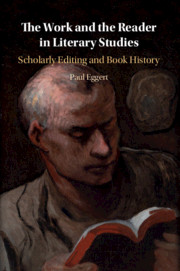Book contents
- The Work and the Reader in Literary Studies
- The Work and the Reader in Literary Studies
- Copyright page
- Dedication
- Contents
- Figures
- Preface
- Chapter 1 Introduction
- Chapter 2 Reviving the Work-Concept
- Chapter 3 The Digital Native Encounters the Printed Scholarly Edition Called Hamlet
- Chapter 4 The Reader-Oriented Scholarly Edition
- Chapter 5 Digital Editions
- Chapter 6 The Work, the Version and the Charles Harpur Critical Archive
- Chapter 7 Book History and Literary Study
- Chapter 8 Book History and Literary Study
- Chapter 9 Adaptation, Folklore and the Work
- Chapter 10 Conclusion
- Notes
- Bibliography
- Index
Chapter 10 - Conclusion
What Editors Edit, and the Role of the Reader
Published online by Cambridge University Press: 19 August 2019
- The Work and the Reader in Literary Studies
- The Work and the Reader in Literary Studies
- Copyright page
- Dedication
- Contents
- Figures
- Preface
- Chapter 1 Introduction
- Chapter 2 Reviving the Work-Concept
- Chapter 3 The Digital Native Encounters the Printed Scholarly Edition Called Hamlet
- Chapter 4 The Reader-Oriented Scholarly Edition
- Chapter 5 Digital Editions
- Chapter 6 The Work, the Version and the Charles Harpur Critical Archive
- Chapter 7 Book History and Literary Study
- Chapter 8 Book History and Literary Study
- Chapter 9 Adaptation, Folklore and the Work
- Chapter 10 Conclusion
- Notes
- Bibliography
- Index
Summary
Bibliography, as defined by W. W. Greg in 1932, excluded meaning; it was to deal only with documentary inscriptions as physical things. This excluded the reader from the editorial equation. A recent series of essays by Hans Walter Gabler repeats the mistake but in a new language.
He proposes that text is based on the fundamental fact of textual variance, and that text is a function of documents. He thus rules out appeal to the biographical author’s intentions. Editorial discourse (emendation, commentary) arises instead, he contends, from the need to explain textual variation.
In contrast, the work model offered in the present book incorporates the reader into text considered as a dimension of experienced meaning. This step requires the meaning of ‘document’ to expand. The two are cast as being in a negative dialectic relationship, dependent on one another to secure their own identities. The embodied work emerges as a regulative concept that embraces the successive iterations of the dialectic over time, around which a new literary studies could be organised. It is argued that Gabler’s binary synchronic needs replacing with a diachronic semiotics such as C. S. Peirce’s.
Keywords
- Type
- Chapter
- Information
- The Work and the Reader in Literary StudiesScholarly Editing and Book History, pp. 167 - 179Publisher: Cambridge University PressPrint publication year: 2019

